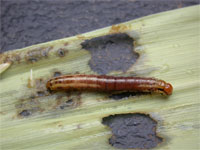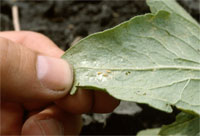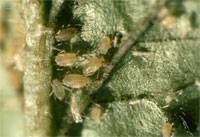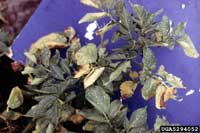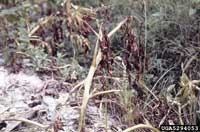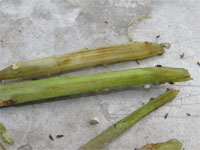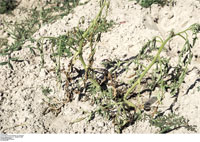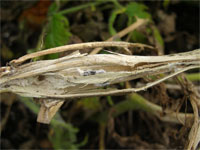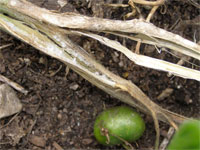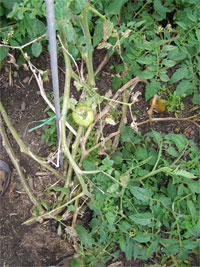Extension > Garden > Diagnose a problem > What's wrong with my plant? > Vegetable > Tomato > Wilting/drooping leaves
Tomato > Leaves > Wilting/drooping leaves
1 of 6
Stalk Borers
- Damage occurs June to early August
- Leaves wilt
- Entrance hole where the caterpillar bores into the stem near ground level
- Caterpillar can sometimes be found in stem
- 3/4 to 2 inches long
- Reddish brown head, brownish purple body with whitish stripes
- More information on Stalkborers
2 of 6
Aphids
- Active during spring and summer
- Feeding by small or moderate numbers of aphids usually does not cause visible symptoms; feeding by larger numbers of aphids can cause curling, stunting, and wilting of leaves
- 1/10th inch long
- Small insects, pear-shaped, usually greenish; clustered on leaves
- More on aphids
3 of 6
Verticillium Wilt
Verticillium albo-atrum, Verticillium dahlia
- A yellow wedge shaped lesion on leaf often with a brown center
- Leaves yellow and wilt, often one side only
- Lower leaves wilt first, eventually whole plant wilts
- In a lengthwise cut of the stem near the soil line, veins are tan, center is green
- Common in cool temperatures 68° to 75° F
- More information on Verticillium Wilt
4 of 6
Fusarium Wilt
Fusarium oxysporum
- Problem in heirloom varieties; most modern cultivars are resistant
- Leaves yellow and wilt, often one side only
- Lower leaves wilt first, eventually whole plant wilts
- In a lengthwise cut of the stem near the soil line, veins are brown, center is green
- Occurs when air and soil temperature are above 80° F
- More information on Fusarium Wilt
5 of 6
White Mold
Sclerotinia sclerotiorum
- Dark, firm water-soaked lesion on stem
- Girdled stems die and turn bone white
- Inside dead stems are black mouse poop shaped sclerotia
- Fruit are soft and rotted
- Cottony white mycelia inside and outside infected stems when humidity is high
- Favored by cool humid conditions
- More information on White Mold
6 of 6
Cold injury
- Leaves look water-soaked and soft, then turn black
- Fruit becomes soft water-soaked and rots
- Leaves show injury immediately, fruit may not show symptoms for 5 to 7 days
- Occurs at temperatures below 50° F




